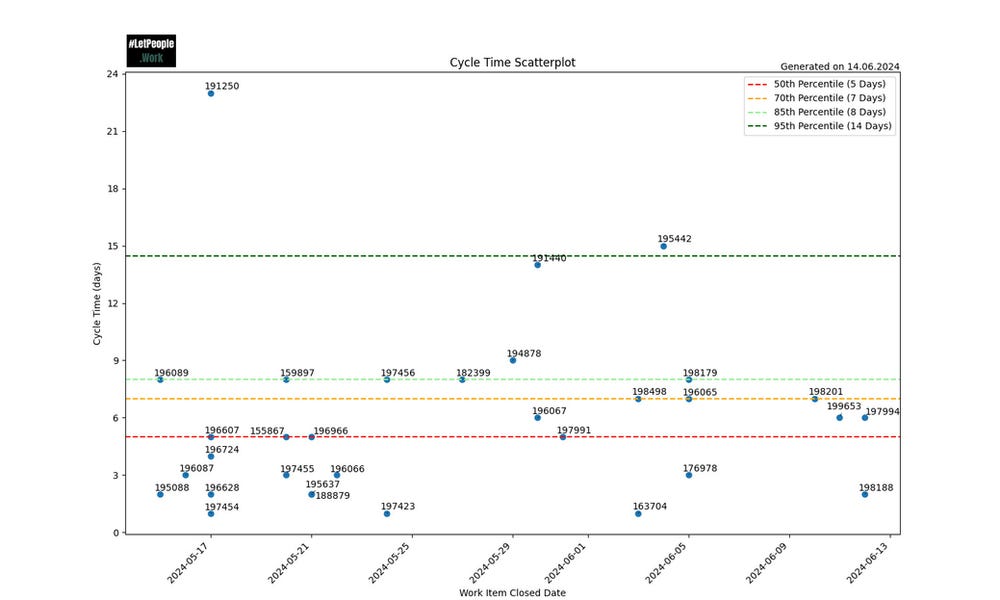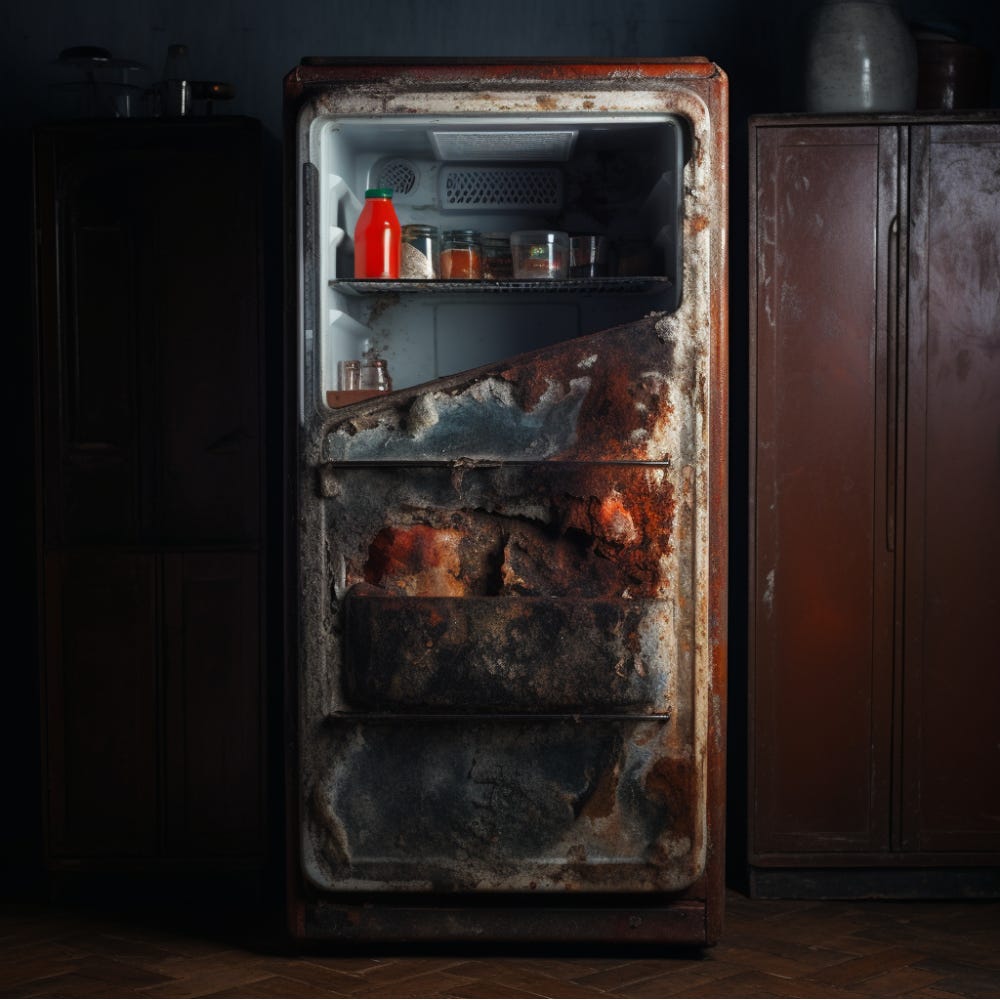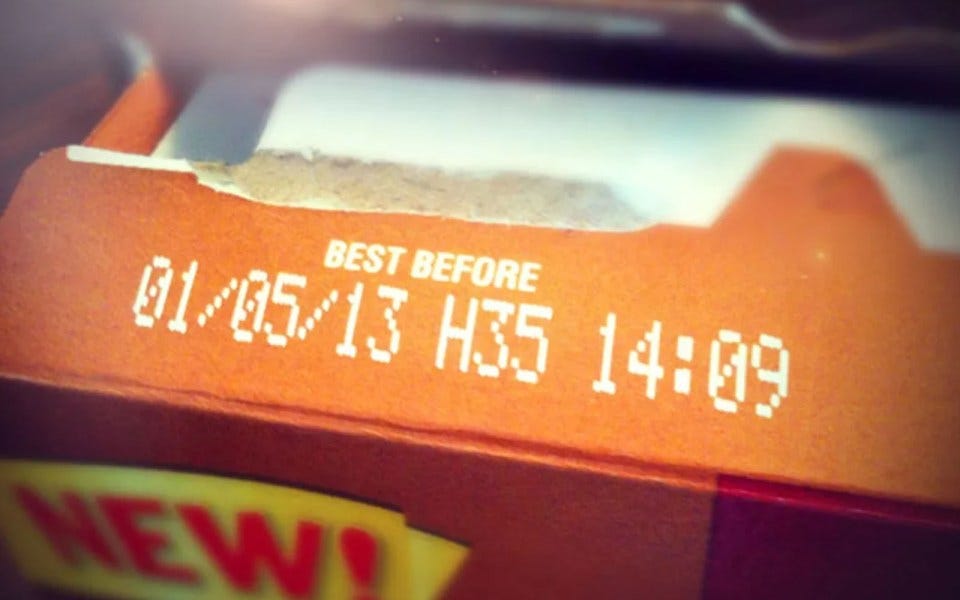What does a Fridge have to do with Flow? - An Analogy to Explain Flow Metrics
In a previous post, we introduced Flow Metrics, explained how to use them, and shared ways to visualize them. If you are about to introduce the concept of those metrics to a group for the first time, it can come in handy to have a good analogy.
This post shows how you can use a regular fridge to explain the four Flow Metrics. Furthermore, we'll share a template that you can use if you want to get a quick start to running a workshop with your team.
How is a Fridge related to Flow?
That might be the question you were asking yourself. We'll get there in a bit, but why don't take a few seconds to think about it and see what you can come up with? Maybe get up, check out your fridge, and grab a glass of water (stay hydrated!) before you read on.
We asked the above question to participants in our workshops, and the following is a selection of answers we received:
It's like a "backlog"
Items can be outdated and spoiled
Anything that's on top gets used first
More people in the household = fuller fridge
Stuff in the bottom is easily forgotten and starts to stink
Small (and delicious) things are finished faster (or in "one serving") while big items are started but maybe not finished before they start to go bad
The following are our thoughts:
A fridge is like a refined backlog. It contains items that you plan to consume in the next few weeks.
Analog to a Kanban Board, you might have a system in your fridge to visually indicate what is "old" or what is "in progress" for a longer time already. For example, items that were started are placed where you can see them easily (don't put the opened yogurt somewhere in the back...).
You can replenish your fridge at different intervals. Maybe you keep your "stock" low (for example if you live in a city and have easy access to stores) or you "fill it up" once a week if you have to drive 30 minutes to the next grocery store.
Items occupy space until you have fully consumed them
In our experience, everyone has had their experience with items in a fridge that were forgotten and started to smell, or stocking up too many things and then having to throw away items that were going bad. Ideally, we learn from this and adjust our behavior, for example, we buy less food to prevent food waste.
As it turns out, many of our learnings can be applied as well to our backlogs with work items. Instead of preventing food waste, we'll prevent items from aging till they go bad and we can improve flow. Let's take a closer look at this.
Flow Metrics
As per the Kanban Guide, there are four Flow Metrics. Let's look at each of them and relate them to our fridge example. For each metric, we share its definition and how it would apply to a fridge.
We also share a question to trigger a discussion that you may have within your team. In our experience, there are many different angles to look at those questions, and there is not a single "best" answer. As you stock fridges differently if you live in the city center versus in the countryside, every team's environment is also different.
If you are introducing your team to Flow Metrics, you may also encourage them to think about how those metrics influence each other (in the fridge example). What happens to the "Cycle Time" of your food if you keep a "high WIP"?
Work In Progress (WIP)
Work in Progress is defined as "The number of work items started but not finished". You can translate this to "How many items are in the fridge?". And you can measure this by simply counting the items you have in your fridge (or "in progress").
How many items are in the fridge?
Important: We count the items independent of their size. Whether you have a yogurt or a turkey in your fridge, it's still just one item.
Discussion Questions: What happens when the fridge is too full?
Respectively what is the consequence of having a very low WIP?
Potential Consequences of a high WIP
Lots of half-eaten food
Overwhelmed with too much to choose from
Poor visibility of food that needs to be eaten soon
Items might get spoiled
No need to worry that you don't have anything to eat at home
If a power outage hits, you are left with lots of things that go bad quickly
Potential Consequences of a low WIP
You may not be able to cook enough of the dishes you want
Need to go grocery shopping more frequently
If a storm hits, you will be out of food rather quickly
Depending on your team's context, you might aim for different numbers in WIP. If you expect a storm, you stock up differently. Similarly, if you have easy access to groceries 24/7, you probably won't need to have it fully stocked.
Throughput
Throughput is defined as "The number of work items finished per unit of time". You can translate this to "How many items are taken out of the fridge over a given unit of time?". Examples are "2 per day" or "11 per week".
How many items are taken out of the fridge?
Important: The measurement of the throughput is the exact count of items. As with WIP above: Their size is irrelevant to the metric.
Discussion Questions: What happens if we don't take out any items from the fridge (no/low Throughput)?
What's the consequence of taking out a lot of items? (High Throughput)
Potential Answers for what happens if we have no or low Throughput
If we don't take anything out, items get spoiled
We don't have to go grocery shopping for a while
Potential Consequences of a High Throughput
We create space for new items
Better chance that we prevent food waste (we use things before they go bad)
We run out of food quicker
If you have a somewhat consistent Throughput, you can also plan your grocery shopping accordingly. If you finish 10 items per week, you may shop for roughly 10 new items every week (or 5 new items twice per week...).
Work Item Age (WIA)
Work Item Age is defined as "The amount of elapsed time between when a work item started and the current time". In the example of a fridge, it's how long something is already in your fridge. The longer something is in there, the more likely it is to become expired. So it makes sense to focus on older items, as the chance that they go bad is higher. This also means that it makes sense to buy small portions over big ones (unless you plan to prepare a meal for many people).
The longer something is in the fridge, the more likely it is to become expired
Discussion Questions: What happens if we leave some items for a very long time in the fridge (it has a high Work Item Age)?
What's an easy way to prevent items from aging?
Consequences of letting items age for a long time
The fridge needs clean-up
We might have to throw away food as it goes bad
We can't cook a meal because an old item is not usable anymore
Something might get smelly and even affect other things in the fridge
Potential Ways to Prevent Items from Aging
Always finish up an item, never put a "half-done" thing back in the fridge
Put older items somewhere visible
Plan how to use up started things
Don't buy too much stuff
Swarm - Cook a meal with your friends and finish up the started items
Sometimes it might seem like a good deal to buy that 1000g of chicken because it's cheaper. But remember, whether you buy 200g or 1000g of chicken, it will expire the same day. If you have to throw away half of it, you might not have saved a lot (if anything). Smaller portions combined with proper planning (what do you plan on eating, when will you go grocery shopping again) will help you prevent aging items.
Similarly, sometimes we feel it's "easier to work on bigger batches". Like with the chicken, it often makes sense to slice it into several small portions to keep the age low. And if that's not possible, make sure you invite your friends to work on the big item.
Cycle Time
Cycle Time is defined as "The amount of elapsed time between when a work item started and when a work item finished". In the example of a fridge, it's how long something tends to stay in your fridge. When you know that 85% of all the items are taken out within 5 days, you have a good idea of how long the items you buy should last. It's also a good indication of when you have to plan your next trip to the grocery store.
How long something tends to stay in your fridge.
Good to Know: The "Work Item Age" becomes the "Cycle Time" the moment we finish an item.
Discussion Question: What can you do with the information that 85% of all your items are consumed within 7 days or less?
Potential Answers
You might not buy items that are expiring within 1-2 days (unless you have a concrete plan to use them)
You know that you probably should go grocery shopping at least once per week
Considering your historical Cycle Time, you can judge items based on their "best before" dates. This doesn't mean you cannot buy anything that expires earlier, but it allows you to make more informed decisions. Buy that 1000 g of chicken for your dinner with friends tomorrow, but maybe go for something else if you have no plans to consume it very soon.
What Does Your Team's Fridge Look Like?
After you introduced the four flow metrics using the fridge analogy and discussed them together, you may want to ask "How does our fridge look like?":
Are you filling it up too often, without having enough space?
Are you living in the city center or the countryside?
Does it smell? Does it need a clean-up?
In our experience, the examples using a fridge are easily understood, and most often there is consensus about not wanting to waste food and letting it go bad. Many of the strategies you come up with for doing that can be applied to your backlog as well:
What should be the "best before" date for items you work on?
How can create smaller portions that are more easily consumable?
In what ways can we prevent items from aging?
Running a Workshop
If you'd like to run a workshop to introduce Flow Metrics or any other topic around the flow of potential value, you can always contact us and have a chat - with no strings attached.
Furthermore, we offer a Miro Template to run a workshop yourself. You can find it on Miroverse and a PDF version.








I love the fridge analogy! I remember seeing this post on LinkedIn and thinking "Damn, this guy is good at explaining things!". Keep on rocking, Benji!